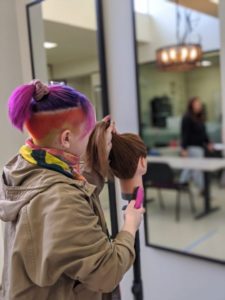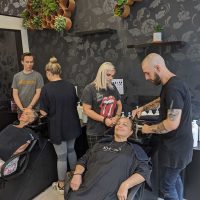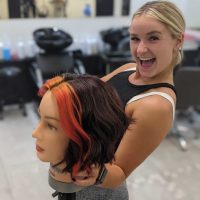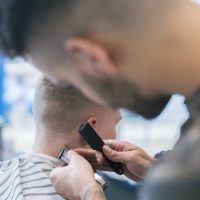[et_pb_section fb_built=”1″ _builder_version=”4.0.7″][et_pb_row column_structure=”2_3,1_3″ _builder_version=”4.0.7″][et_pb_column type=”2_3″ _builder_version=”4.0.7″][et_pb_post_title author=”off” date=”off” comments=”off” _builder_version=”4.0.7″ global_module=”1053″ saved_tabs=”all”][/et_pb_post_title][et_pb_text _builder_version=”4.0.7″ hover_enabled=”0″]
HOW TO ACHIEVE EXCELLENT CUSTOMER SERVICE IN BEAUTY THERAPY AND HAIRDRESSING.
An integral part of the hairdressing and beauty industry is excellence in client service. This is achieved by providing the client with an efficient service with which they are satisfied. By achieving these standards, the client will be encouraged to return to a beauty business for future services and treatments, and may also recommend the business to others.
WE ARE IN A SERVICE INDUSTRY. BY HAVING TREATMENTS IN YOUR CLINIC THE CLIENT IS PAYING FOR YOUR HOME, FOOD AND EVERYTHING YOU DO IN LIFE. SHE/HE IS SPENDING HER/HIS HARD EARNED MONEY ON THE TREATMENT OR PRODUCT THAT YOU ARE GOING TO BE SELLING. YOUR CLIENT ALWAYS DESERVES THE VERY BEST THAT YOU CAN GIVE.
Every workplace is going to have a different way of doing everything in the clinic. However the clinic should “do” everything the same for every client. It should not matter who the practitioner is giving the treatment: every client deserves the very best treatment. The way the client is greeted, to the way the treatment is set up and completed; to the way the client is farewelled should be identical. This way it does not matter if one member of staff is away sick or has left. The client will always have the same service. Certainly there is always going to be a personality in the individual therapist but the way the service is done MUST be the same.
[/et_pb_text][et_pb_image _builder_version=”4.0.7″ src=”https://www.marjoriemilner.edu.au/wp-content/uploads/2020/01/Beauty_Therapy_500w-300×224-1-1.jpg” hover_enabled=”0″][/et_pb_image][et_pb_text _builder_version=”4.0.7″ hover_enabled=”0″]
Good Customer Service
How to communicate with clients:
Personal – clients will be speaking to you from the first instant they arrive. You need to ensure that your language is within the appropriate language of a clinic. Although you live here in Australia; it is not appropriate to say things like “would yous like to come to the wax room.” You have to speak in a clinic voice; not loud; but softly spoken.
Telephone – The first contact with a client is via the telephone. Always smile on the telephone, it shows in your voice
Verbal and non verbal – The verbal is clear & concise but the non verbal communications are your body language, the tone of your voice, the look on your face!
Culturally appropriate greetings and farewells- in other words, if you have a non Christian client, don’t wish her/him Happy Christmas or Happy Easter. Talk about having a wonderful holiday period. Or if you have client a great deal older than you, speak in a respectful manner. Offer a chair; sit at the same level as them; not you standing and them sitting.
Clients may include but are not limited to:
New or regular clients with routine or special needs: clients with special needs may be challenging to your ability as a therapist and also challenging in your clinic environment. You may have a client that is sight impaired and has a guide dog. By law this dog is allowed into the clinic room. Or you might have a client who is in a wheelchair and not all clinics will be able to accommodate a wheelchair as the clinic room maybe too small or the person would not be able to get up the flight of stairs. You could if your workplace would allow it, suggest that the client is seen in her home so that the client does not miss out on the treatment or you could suggest that another salon might be able to accommodate her.
Male or female clients
People from a range of social, cultural and ethnic backgrounds with varying physical and mental abilities
1. HOW TO RECEIVE CLIENTS
Without clients there would be no business and no job for you, so you have a good reason to be genuinely pleased to see any client visiting your workplace. Every time you receive and greet a new client, you have the opportunity to initiate an effective and positive relationship. Your greeting should be sincere and welcoming. Your aim is to make the client feel special.
First impressions are usually lasting impressions. To many clients, you are the face of the business. When a client says, ‘I always come here, it’s so friendly and relaxing’, this usually means that the interpersonal communications with staff made them feel good, rather than a comment on the interior design. The impression of friendliness is created by the way the staff communicates and the attitudes conveyed through their interactions.
2. WORKPLACE COMMUNICATION
Communication is about sending and receiving messages. Unless the message is both sent and received communication does not happen. For example, a client could ask for an appointment for a leg wax and you would write the appointment in the book. If your client sat at home and only thought about making an appointment and did not telephone you, then the message would not be sent or received.
A message may be communicated verbally or non-verbally.
3. VERBAL
Verbal communication means using words; the words may be spoken or written. A client may say ‘I am cautious about having my ears pierced.’ In spoken communication, tone, pitch, speed and the emphasis that is placed on what is being said is also important. If the client said ‘I am cautious about having my ears pierced’ in a shaky voice, it may indicate that your client is in fact very nervous, not just cautious.
4. NON-VERBAL
Non-verbal communication is visual. This type of communication includes signs or symbols displayed, or the body language you are projecting, such as facial expressions, eye contact or physical movements, which include head, hand and arm movements. For example, ‘I am cautious about having my ears pierced’ may be accompanied by a frown and shaking hands.
5. EFFECTIVE COMMUNICATION
Receiving the message is just as important as sending it. If a message is sent but not received, no communication has taken place. Receiving a message means:
- listening if the message is spoken
- reading if the message is written
- noticing if the message is non-verbal
Over the Phone:
Your communication with clients may be in person or over the phone. When communicating in person, remember that your body language conveys a great deal of information to the client. In both cases, in person and on the telephone, your tone of voice can actually change the meaning of the words you say.
Keep the following objectives in mind in all workplace communications:
- be sure of the message you are trying to convey
- speak clearly in a pleasant tone of voice
- use easily understood language; avoid jargon or highly technical terms
- talk at a reasonable pace, not too fast or too slow
- check that your communication is understood
- be patient and sincere
- listen carefully and attentively
- ask questions to check your own understanding
- use friendly and welcoming body language
- accept others as they are, without judgement
- use humour appropriately; no loud laughing and no rude or inappropriate jokes
Most workplaces have standards for communicating with clients in person and on the telephone. These differ according to the ambience and style the owner or manager wants to create. The standards may be verbal (the way we do things) or incorporated into written procedures;
Workplace policies and procedures may include:
- Communicating with clients
- Customer service techniques
- Promoting products and services
- Handling complaints
- Personal presentation
- Record keeping
- Scheduling clients
- Processing sales and refunds
- Complaint resolutions
Some workplaces have a relaxed, informal style, which suits their clients’ needs and expectations. Other workplaces have more formal procedures in place for welcoming clients. You need to understand the overall impression the workplace is seeking to make. Both your personal presentation and conversational style must match the impression the business owner intends.
Most workplaces have procedures for greeting people by telephone, and handling messages and enquiries, these procedures may include:
- answering the phone after three rings
- Using the company greeting, for example, ‘Good afternoon, Natural Skincare Clinic, Jennifer speaking, how can I help you?’
- or; thank you for calling the Natural Skincare Clinic, Jennifer speaking, how can I help you?
- writing down the name of the caller, the company, if relevant, and the reason for the call
- using the caller’s name during the conversation.
- listening carefully and attentively, using feedback such as ‘Yes’, ‘I see’, and repetition of the caller’s request – ‘So you’d like to have a ½ leg wax next Tuesday; is that correct’
- asking questions, where appropriate
- sounding friendly and attentive by actually smiling, even though no one is watching
- explaining fully what actions you are taking, and gaining consent from the caller, especially when placing the caller on hold or transferring the call
- closing the conversation by stating clearly your understanding of what the follow up action will be.
- farewelling the client by saying, for example, ‘thank you for calling and we look forward to seeing you soon’.
- Another way is to say “I hope that you enjoyed your treatment, I look forward to seeing you for your next appointment on Tuesday the 25th July at 2p.m.”
Some of this information comes from the Unit SIBXCCS202A Provide Service to Clients. This unit was written for the beauty therapy training package. This was written by Bev Greenwood.
[/et_pb_text][/et_pb_column][et_pb_column type=”1_3″ _builder_version=”4.0.7″][et_pb_sidebar area=”sidebar-1″ _builder_version=”4.0.7″ global_module=”1039″ saved_tabs=”all”][/et_pb_sidebar][/et_pb_column][/et_pb_row][/et_pb_section]
























